 |
 |
 |
 |
 INSTALLING THE SINGLE
- POLE
INSTALLING THE SINGLE
- POLE
TOGGLE SWITCH
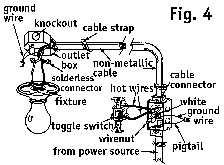 The simplest switch system - the single-pole toggle
switch - is illustrated in Fig. 4. The ordinary single-pole toggle switch provides a means
for breaking or feeding electrical current to a light, appliance, etc.
The simplest switch system - the single-pole toggle
switch - is illustrated in Fig. 4. The ordinary single-pole toggle switch provides a means
for breaking or feeding electrical current to a light, appliance, etc.
The single-pole toggle switch has two brass terminal screws. One wire (usually the black) is cut, then is connected to the two brass terminals. The other wire (white) is uninterrupted from the power source to the light or fixture.
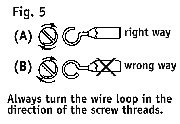 When connecting a wire to the terminal screw of a
switch, always turn the loop on the end of the wire in the same direction as the screw
threads, as shown in illustration A, Fig 5. If the loop is turned in the opposite
direction (B), tightening the screw will loosen the loop.
When connecting a wire to the terminal screw of a
switch, always turn the loop on the end of the wire in the same direction as the screw
threads, as shown in illustration A, Fig 5. If the loop is turned in the opposite
direction (B), tightening the screw will loosen the loop.
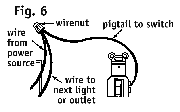 If the wire connects to the terminal screw and then
runs on, cut and strip the wire on both sides of the cut. Using a 6" piece of wire
with both ends stripped (sometimes called a pigtail) and a wirenut, fasten the three wires
together. Connect the pigtail to the terminal, as in Fig. 6.
If the wire connects to the terminal screw and then
runs on, cut and strip the wire on both sides of the cut. Using a 6" piece of wire
with both ends stripped (sometimes called a pigtail) and a wirenut, fasten the three wires
together. Connect the pigtail to the terminal, as in Fig. 6.
 Use wirenuts or screw-on connectors to save time and
effort when you must make a splice in any electrical wire (Fig. 7). Always cover any
soldered connection with insulating tape. If soldered sections are rough, apply an extra
layer of tape. Insulate the wire an additional inch or two beyond the soldered connection
in each direction.
Use wirenuts or screw-on connectors to save time and
effort when you must make a splice in any electrical wire (Fig. 7). Always cover any
soldered connection with insulating tape. If soldered sections are rough, apply an extra
layer of tape. Insulate the wire an additional inch or two beyond the soldered connection
in each direction.
White wires should generally be attached to light colored terminal screws such as silver. Black wires should generally be attached to dark colored screws such as brass colored. If the terminal screws are the same color, either wire can generally be attached to either terminal. Green terminal screws are for grounding wires.
 INSTALLING SWITCH
OUTSIDE
INSTALLING SWITCH
OUTSIDE
MAIN WIRING RUN
Use an ordinary toggle switch for installations outside the main wiring run. Shut off
all current at the main service panel. At the light fixture, connect the black wire from
the switch to the black wire from the light fixture. Connect the white wire from the
switch to the black wire from the power source. (Fig. 8). 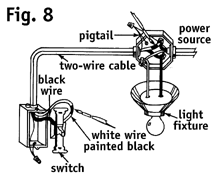 CAUTION: Anytime it is necessary to connect a white and black wire
together, take the time to paint the white wire black at both ends to indicate that the
white wire is attached to a power source. Connect the white wire from the light fixture to
the white wire from the power source.
CAUTION: Anytime it is necessary to connect a white and black wire
together, take the time to paint the white wire black at both ends to indicate that the
white wire is attached to a power source. Connect the white wire from the light fixture to
the white wire from the power source.
At the light switch, connect the black wire to one terminal and the white wire to the other. Remember, a green screw is always for the ground wire.
 INSTALLING IN - LINE
SWITCH FOR
INSTALLING IN - LINE
SWITCH FOR
CONTROL OF ONE LIGHT
Shut off all current at the main service panel. A third wire (red, Fig. 9) must be added to the power cable for this switch arrangement. The red wire serves as a black wire from the switch to the light or outlet which is to be controlled.
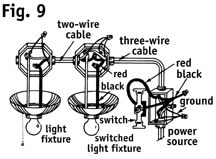 Study the diagram in Fig. 9 carefully. You will
note that the white wire feeds continuously from the power source to all fixtures. The
black wire is pigtailed on one terminal of the switch, while the red wire attaches to the
other terminal. The black wire then runs continuously through to the light or outlet which
is not controlled, while the red wire runs from the switch terminal to connect with the
black wire on the controlled light or outlet.
Study the diagram in Fig. 9 carefully. You will
note that the white wire feeds continuously from the power source to all fixtures. The
black wire is pigtailed on one terminal of the switch, while the red wire attaches to the
other terminal. The black wire then runs continuously through to the light or outlet which
is not controlled, while the red wire runs from the switch terminal to connect with the
black wire on the controlled light or outlet.
This arrangement allows the switch to control the first light or outlet while power continues uninterrupted to the second fixture.
 INSTALLING SWITCH
AND
INSTALLING SWITCH
AND
CONVENIENCE OUTLET
IN SAME BOX
Shut off all current at the main service panel. At the double-switch box (Fig. 10), connect a pigtail to the brass terminal on the outlet and another pigtail to either of the terminals on the switch. Wirenut these two pigtails and the black wire from the light fixture together. Connect the white wire from the light fixture to the silver terminal on the outlet. Connect the red wire from the light fixture to the other terminal on the switch.
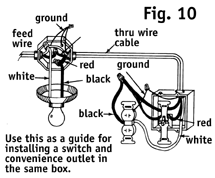 At the light fixture, wirenut the white wires from
the power source, the light fixture and the switch together. Wirenut the black wires from
the power source and the switch together. Wirenut the red wire from the switch and the
black wire from the light fixture together.
At the light fixture, wirenut the white wires from
the power source, the light fixture and the switch together. Wirenut the black wires from
the power source and the switch together. Wirenut the red wire from the switch and the
black wire from the light fixture together.
 INSTALLING TWO
PARALLEL SWITCHES
INSTALLING TWO
PARALLEL SWITCHES
FOR CONTROL OF TWO
SEPARATE LIGHTS
Shut off all current at the main service panel. At the switch box, attach a pigtail to one of the terminals on switch 1 (Fig. 11). Connect a second pigtail to one of the terminals on switch 2. Wirenut these two pigtails and the black wire from the light fixture together. Connect the red wire from the light fixture to the other terminal on switch 1. Connect the white wire from the light fixture to the other terminal on switch 2. Be sure to paint the white wire black.
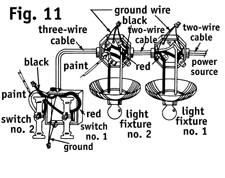 At light fixture 1, wirenut the black wire from the
power source and the black wire leading to light fixture 2 together. Wirenut the white
wires from the power source, light fixture 1 and light fixture 2 together. Wirenut the
black wire from light fixture 1 and the red wire to light fixture 2 together.
At light fixture 1, wirenut the black wire from the
power source and the black wire leading to light fixture 2 together. Wirenut the white
wires from the power source, light fixture 1 and light fixture 2 together. Wirenut the
black wire from light fixture 1 and the red wire to light fixture 2 together.
At light fixture 2, wirenut the black wires from light fixture 1 and the switches together. Wirenut the white wires from light fixture 1 and light fixture 2 together. Wirenut the red wires from switch 1 and light fixture 1 together. Wirenut the white wire from switch 2 and the black wire from light fixture 2 together. Be sure to paint the white wire black.
 HOW A THREE - WAY
HOW A THREE - WAY
SWITCH WORKS
The illustration in Fig. 12 uses open knife switches to demonstrate how a three-way switch works. Wire No. 1 feeds directly from the power source to the light fixture. However, power must be fed through two wires for the light to function. The flow of power through wire No. 2 is continued or broken by the two switches, as illustrated.
 Power through wire No. 2 reaches the first switch
at the center or common terminal (A). If the knife switch handle were in position (B), the
current would flow through to terminal (D). However, this arrangement would not provide a
continuous power flow since the knife switch, as illustrated, is at position (G). The
light bulb would not be illuminated.
Power through wire No. 2 reaches the first switch
at the center or common terminal (A). If the knife switch handle were in position (B), the
current would flow through to terminal (D). However, this arrangement would not provide a
continuous power flow since the knife switch, as illustrated, is at position (G). The
light bulb would not be illuminated.
Since the first switch is at position (C), the current flows directly through terminal (E) to terminal (F), then through handle (G) to turn on the light. Note that when either handle is placed in the opposite position, the circuit is broken and the light is not illuminated.
Note also that if you swing either handle to the opposite position, the current flow is made continuous and the light goes on again. Obviously, knife switches are not used in an electrical installation. They are used here simply to illustrate what happens inside an ordinary three-way switch when it is installed.
 THREE - WAY SWITCHES FOR LIGHT
THREE - WAY SWITCHES FOR LIGHT
CONTROL BEYOND SWITCHES
 Shut off all current at the main service panel. At
the light fixture, wirenut the white wires from the power source and the light fixture
together (Fig. 13). Wirenut the black wires from the power source and the switches
together. Wirenut the black wire from the light fixture and the white wire from the
switches together. Paint the end of the white wire black.
Shut off all current at the main service panel. At
the light fixture, wirenut the white wires from the power source and the light fixture
together (Fig. 13). Wirenut the black wires from the power source and the switches
together. Wirenut the black wire from the light fixture and the white wire from the
switches together. Paint the end of the white wire black.
At switch 1, locate the terminal on the three-way switch that is marked as common and attach the red wire. Attach the black wire to either of the two remaining terminals. Attach the white wire to the last terminal.
At switch 2, locate the terminal on the three-way switch that is marked as common and attach the red wire. Attach the white wire from switch 1 to either of the two remaining terminals. Paint the end of the wire black. Attach the black wire from the light fixture to the last terminal. Wire the black wire from switch 1 and the white wire from the light fixture together. Paint the end of the white wire black.
 THREE - WAY SWITCHES FOR LIGHT
THREE - WAY SWITCHES FOR LIGHT
CONTROL BETWEEN SWITCHES
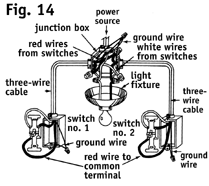 Shut off all current at the main service panel. At
switch 1, find the terminal marked as common and attach the red wire (Fig. 14). Attach the
white wire to either of the two remaining terminals. Attach the black wire to the last
terminal.
Shut off all current at the main service panel. At
switch 1, find the terminal marked as common and attach the red wire (Fig. 14). Attach the
white wire to either of the two remaining terminals. Attach the black wire to the last
terminal.
At switch 2, find the terminal marked as common and attach the red wire. Attach the white wire to either of the two remaining terminals. Attach the black wire to the last terminal.
At the light fixture, wirenut the two red wires from the switches together. Wirenut the two white wires from the switches together. Wirenut the black wires from the power source and switch 1 together. Wirenut the white wires from the power source and the light fixture together. Wirenut the black wires from the light fixture and switch 2 together.
T O O L A N D M A T E R I A L C H E C K L I S T
| Screwdriver | Two-Wire Feed Cable Three-Wire Feed Cable |
 |
| Side-Cutting Pliers | Wirenuts or Scew-on Connectors | Outlet Boxes |
| Knife for Stripping Wire | Cable Connectors | Toggle Switches |
| Keyhole Saw | Pigtails | Three-Way Switches |
| Insulating Tape |  |
Cable Straps |